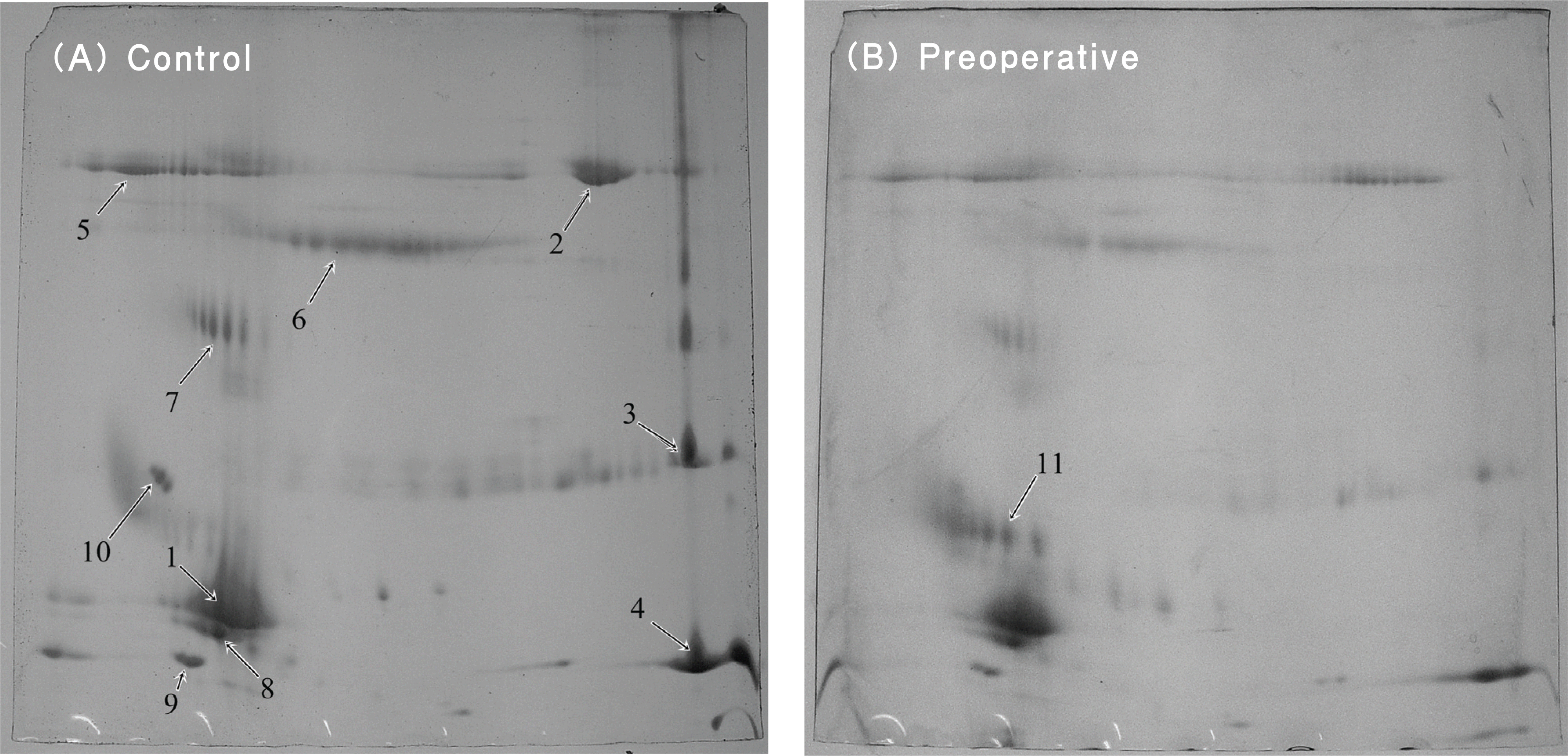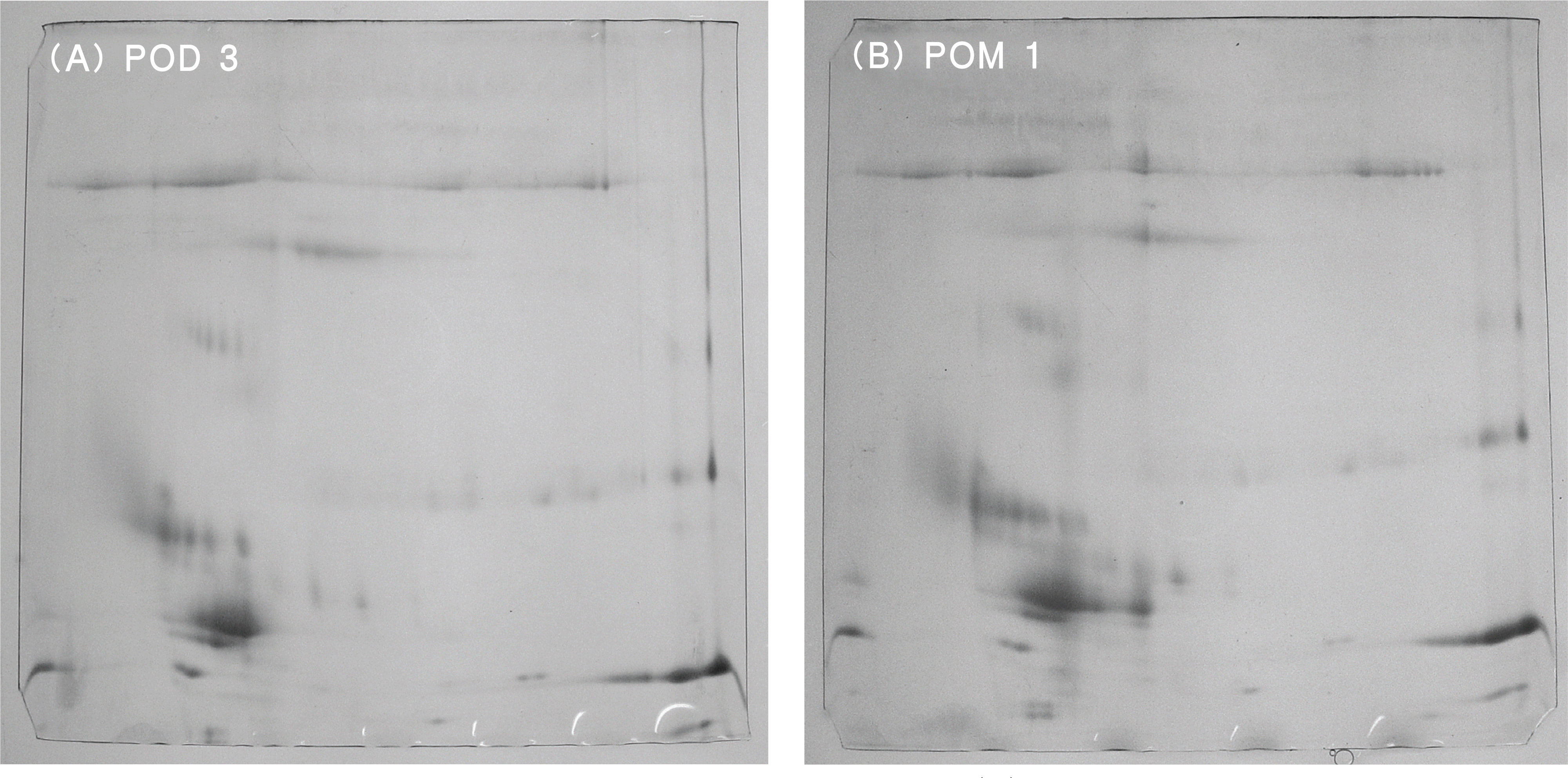Abstract
Purpose
To investigate the change in the tear protein composition of patients who underwent refractive surgery.
Methods
Tear samples were collected before photorefrative keratectomy (PRK), on the first, the second, and the third postoperative day, and then a month after the operation from 40 eyes of 20 patients. These tear samples were analyzed using two-dimensional gel electrophoresis (2-DE). Matrix-associated laser desorption/ionization time of flight (MALDI-TOF) was employed for the identification of expressed proteins. Control tear samples were collected from 40 eyes of 20 healthy volunteers who had no history of ocular surgery or pathology.
Results
On the first postoperative day, lipocalin-1 precursor, lipocalin-1, and lysozyme were up-regulated. On the second postoperative day, serum albumin precursor and serum albumin were up-regulated. The tears collected on the third postoperative day and after 1 month had similar protein expression levels to the control group. Lipocalin 1 precursor and lysozyme were up-regulated and down-regulated after reftactive surgery, respectively. However, each protein had a different molecular weight and isopotential point.
Go to : 
References
1. Trokel SL, Srinivasan R, Braren B. Excimer laser surgery of the cornea. Am J Ophthalmol. 1983; 96:710–5.

2. Shyn KH, Yoon SC. Refractive survey 2005 in Korea. J Korean Ophthalmol Soc. 2008; 49:570–6.
3. Murphy PJ, Corbett MC, O'Brart DP, et al. Loss and recovery of corneal sensitivity following photorefracitve keratectomy for myopia. J Refract Surg. 1999; 15:38–45.
4. Perez-Santonja JJ, Sakla HF, Cardona C, et al. Corneal sensitivity after photorefractive keratectomy and laser in situ keratomileusis for low myopia. Am J Ophthalmol. 1999; 127:497–504.
5. Kanellapoulos AJ, Pallikaris IG, Donnenfeld ED, et al. Comparison of corneal sensation following photorefractive keratectomy and laser in situ keratomileusis. J Cataract Refract Surg. 1997; 23:34–8.
6. Campos M, Hertzog L, Garbus JJ, McDonnell PJ. Corneal sensitivity afterphotorefractive keratectimy. Am J Ophthalmol. 1992; 114:51–4.
7. Kauffmann T, Bodanowitz S, Hesse L, Kroll P. Corneal reinner-vation after photorefractive keratectomy and laser in situ keratomileusis: an in vivo study with a confocal videomicroscope. Ger J Ophthalmol. 1996; 5:508–12.
8. Tervo K, Latvala T, Tervo T. Recovery of corneal innervation following photorefractive keratoabration. Arch Ophthalmol. 1994; 112:1466–70.
9. Tervo T, Virtanen T, Honkanen N, et al. Tear fluid plasmin activity after excimer laser photorefractive keratectomy. Invest Ophthalmol Vis Sci. 1994; 35:3045–50.
10. Vesaluoma MH, Tervo TT. Tenascin and cytokines in tear fluid after photorefractive keratectomy. J Refract Surg. 1998; 14:447–54.

11. Mertaniemi P, Ylatuoa S, Partanen P, Tervo T. Increased release of immunoreactive calcitonin gene-related peptide (CGRP) in tears after excimer laser keratectomy. Exp Eye Res. 1995; 60:659–65.
12. Virtanen T, Ylatupa S, Mertaniemi P, et al. Tear fluid fibronectin levels after photorefractive keratectomy. J Refract Surg. 1995; 11:106–12.
13. Bilgihan A, Bilgihan K, Toklu Y, et al. Ascobic acid levels in human tear after photorefractive keratectomy, transepithelial photorefractive keratectomy, and laser in situ keratomileusis. J Cataract Refract Surg. 2001; 27:585–8.
14. Song WK, Lee HK, Kim HC, et al. Nerve growth factor concentration and implications in photorefractive keratectomy versus laser in situ keratomileusis. J Korean Ophthalmol Soc. 2006; 47:1349–57.
15. Csutak A, Silver DM, Tozser J, et al. Plasminogen activator inhibitor in human tear after laser refractive surgery. J Cataract Refract Surg. 2008; 34:897–901.
16. Fust A, Veres A, Kiszel P, et al. Changes in tear protein pattern after photorefractive keratectomy. Eur J Ophthalmol. 2003; 13:525–31.
17. Joo H, Han J. Proteomics. 1st ed.Seoul: Panmun;2004. p. 38–87.
18. Grus FH, Augustin AJ. Protein analysis methods in diagnosis of sicca syndrome. Ophthalmologe. 2000; 97:54–61.
19. Grus FH, Augustin AJ. Analysis of tear protein patterns by a neural network as diagnostical tool for the detection of dry eyes. Electrophoresis. 1999; 20:875–80.
20. Grus FH, Sabuncruo P, Augustin AJ. Quantitative analysis of tear protein profile for soft contact lenses-a clinical study. Klin Monatsbl Augenheilkd. 2001; 218:239–42.
21. Herber S, Grus FH, Sabuncuo P, Augustin AJ. Two-dimensional analysis of tear fluid patterns of diabetes patients. Electrophoresis. 2001; 22:1838–44.
22. Janssen PT, van Bijsterveld OP. Origin and biosynthesis of human tear fluid proteins. Invest Ophthalmol Vis Sci. 1983; 24:623–30.
Go to : 
 | Figure 1.Representative 2-DE gel map of control and PRK patient tear proteins. (A) The 2-DE gel map of control subject. (B) The 2-DE gel map of preoperative subject. |
 | Figure 2.Representative 2-DE gel map of PRK patient tear proteins. (A) The 2-DE gel map of the first post-operative day subject. (B) The 2-DE gel map of the second postoperative day subject. |
 | Figure 3.Representative 2-DE gel map of PRK patient tear proteins. (A) The 2-DE gel map of the third post-operative day subject. (B) The 2-DE gel map of the subject obtained after a month postoperatively |
Table 1.
Demographic features of PRK and Control
| | | PRK | Control | p-value |
|---|---|---|---|---|
| Age | Mean± SD | 25.35±4.23 | 26.65±2.60 | 0.25 |
| | Range | 19∼30 | 19∼31 | |
| Sex (male/female) | | 4/16 | 6/14 | 0.48 |
Table 2.
Identification of the down-regulated proteins in PRK patients
| Spot No. | Protein | Mw* (KDa) | pI† | Accession No. |
|---|---|---|---|---|
| 1 | Lipocalin 1 precursor | 20 | 4.8 | gi|4504963 |
| 2 | Neutrophil lactoferrin | 97 | 8.4 | gi|34412 |
| 3 | Lysozyme | 31 | 9.2 | gi|1421350 |
| 4 | Lysozyme | 15 | 9.2 | gi|15825835 |
| 5 | Neutrophil lactoferrin | 97 | 4.1 | gi|186818 |
| 6 | MGC27165 Protein | 18 | 4.8 | gi|21619010 |
| 7 | Zn-alpha2-glycoprotein | 15 | 4.5 | gi|38026 |
| 8 | Lipocalin 1 precursor | 59 | 5.9 | gi|4504963 |
| 9 | Cystain S precusor; Cystain 4 | 45 | 4.5 | gi|55667085 |
| 10 | Lacrimal praline-rich protein | 31 | 4.4 | gi|3318722 |
| 11 | Lacritin precursor | 26 | 4.7 | gi|15187164 |
Table 3.
Identification of the up-regulated proteins in PRK patients
| Spot No. | Protein | Mw* (KDa) | pI† | Accession No. |
|---|---|---|---|---|
| 12 | Lipocalin 1 precursor; Lipocalin 1 | 20 | 4.8 | gi|4504963 |
| 13 | Lipocalin 1 precursor; Lipocalin 1 | 20 | 5.6 | gi|4504963 |
| 14 | Lipocalin 1 precursor; Lipocalin 1 | 20 | 6.7 | gi|4504963 |
| 15 | Lysozyme | 15 | 5.1 | gi|12084401 |
| 16 | Lysozyme | 15 | 6.8 | gi|6729881 |
| 17 | Lysozyme | 15 | 8.1 | gi|4930014 |
| 18 | Human serum albumin | 69 | 4.3 | gi|31615330 |
| 19 | Human serum albumin | 69 | 5.8 | gi|3212456 |
| 20 | Human serum albumin precursor | 69 | 6.9 | gi|6013427 |




 PDF
PDF ePub
ePub Citation
Citation Print
Print


 XML Download
XML Download